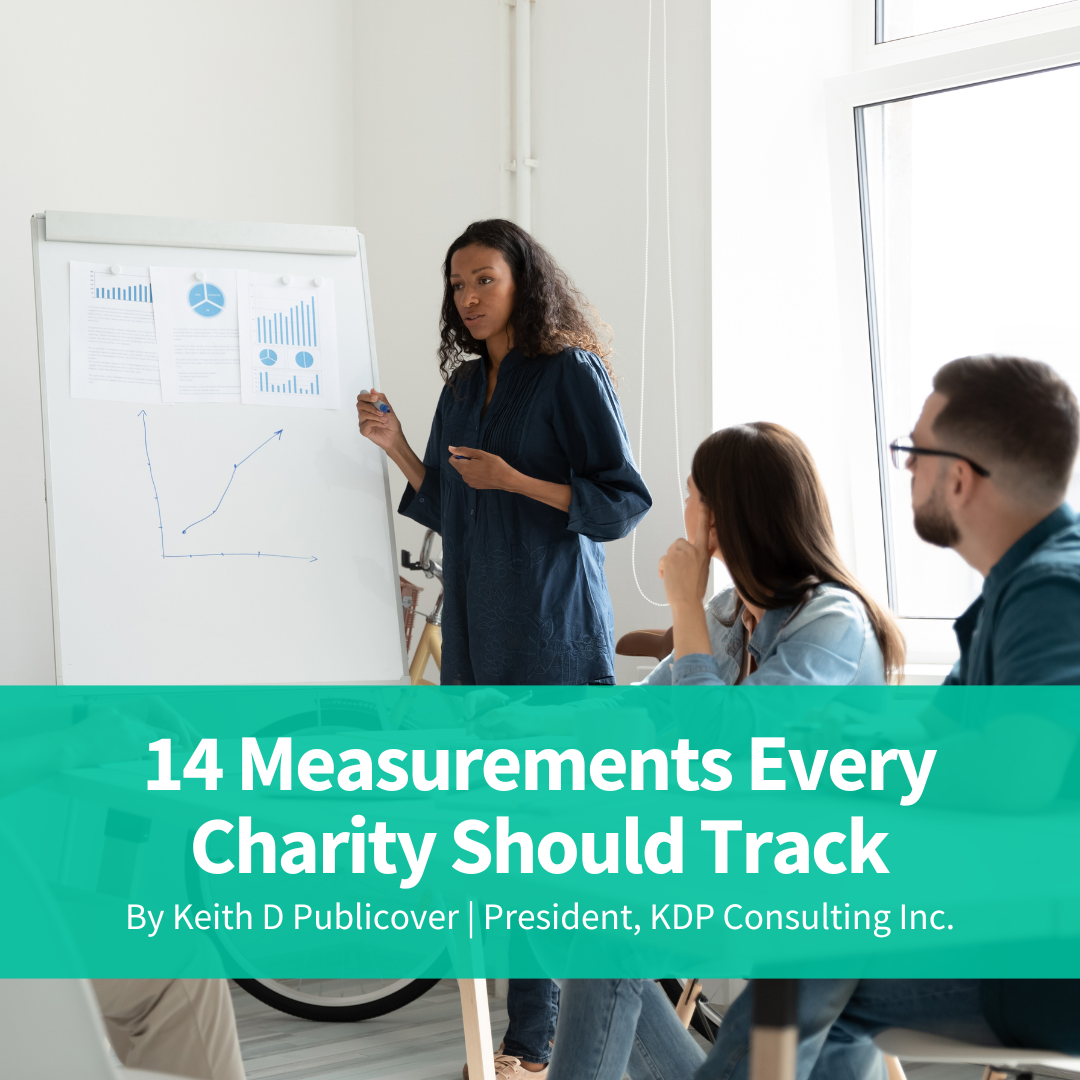
Keith D Publicover, President of KDP Consulting Inc.
There are many ways to define and measure success within the charitable, nonprofit sector. Below I have presented 14 measurements or key performance indicators (KPIs) every charity or nonprofit should track over time to ensure they are sustainable and demonstrating impact within their respective communities.
As you reflect on this list you may determine particular measurements carry more weight of importance over another due to the nature of your organization’s purpose and operating model. Implicit in the list is the need to correlate data sets of one to another or multiple sets, therefore I encourage you to examine them collectively.
- Donor growth – An essential metric to measure year-over-year, while tracking your 5-year comparable history. Breaking down the macro data to analyze growth (or decline) by age, income, gender, type and other criteria can help your team better understand the behavior of your donors, what funding programs resonate with them and where the donor retention may be at risk.
- Donor retention – By looking at retention your charity reinforces the importance of individual donor relationships. Asking questions of why donors are committing over time while others may stop donating or only give once are essential in managing your donor relationship/stewardship programs. Understanding donor retention behaviors also can provide greater insight into donor conversion to other programs (e.g. leadership gifts, capital campaigns, planned legacy gifts).
- Donation growth – Like donor growth, collecting and examining the donation growth data will enable you to sustain your organization, chart strategic fundraising initiatives, manage financial risks and keep a look out for past history that may impact future trends and performance. By examining the data by subset (e.g. donation type, dollar amount and timing) year-over-year and a 5-year history helps to better understand the details that make up your annual macro results.
- Average gift size growth – If you are growing the average gift over time it demonstrates your donors are getting more engaged and committed to your social cause. Comparing the average gift size to your donor retention data, for example, can help you understand the donor motivation and how the donor relationship is developing. Average gifts may increase/decrease however monitoring these numbers along with the increase/decrease of other key performance measures enable your team to view a complete picture of your philanthropic performance and culture.
- Fundraising costs – Charities are operating today under greater scrutiny for the money spent on overheads, including their cost of their fundraising programs. It is prudent then to measure and monitor these costs carefully to look for efficiencies in the spend, measure the return on the investment of the programs and the percentage of donations being redirected to raise more money.
- Pledge fulfillment – There are two measures to examine with pledge fulfillment – percentage of donors honoring pledges and percentage of dollars received per pledge. Gaining an understanding of these numbers can drive the kind of follow-up discussions your team may need with each donor or to determine strategies for future pledge drives.
- Recurring gift percentage – Tied to the donor retention is the percentage of recurring gifts. Understanding these numbers can help create sound, predictable income models and cash flow projections.
- Fundraising ROI – Taking the measurement of fundraising costs further to calculate the return-on-investment (ROI) is invaluable if you are testing new programs like: crowd-funding, special events or one-off campaigns or considering exiting some of your reoccuring development programs.
- Client growth – Dependent upon the nature of your charity’s work in the community, client growth may represent the number of registrations to a program roster, the numbers of individuals cured of disease, placed in long-term care, employed or certified in a job skill to name a few. Charities may want to present these numbers in sets by gender, geography and income group to help gain a more in-depth analysis of the growth they are achieving or pursuing.
- Client retention – Simply tracking the number of clients served year-over-year may not be providing you or your stakeholders with the data they need most. Examining the retention numbers of clients can help you understand client behavior, client support or program delivery models. Perhaps you can expect a participate to complete a program however be retained with your institution in other services, seek in-patient treatment and require on-going out-patient follow up for a time. These examples and others are organization specific, nonetheless charities serve people and measuring client reach and retention across programs/services are valuable in measuring impact.
- Service cost per client – As important as your fundraising cost, the cost of serving your client is essential to managing financial risks, identifying efficiencies of service and communicating to the donor the power of their gift.
- Social media engagement – With the accelerated growth in social media and consumer (stakeholder) use of the SM platforms every charity should be strategically evaluating the impact of SM on their brand. These engagements – specific to the media platform – can be measured in numbers, impressions, clicks and time.
- Volunteer retention – Charities are dependent upon volunteers (e.g. governance, program, fundraising). Recruiting and supporting volunteers is a significant investment of time and money, so it is prudent to measure your volunteer retention over time (e.g. week, month, year). The volunteer landscape is constantly changing therefore measuring retention levels and other related metrics can support your strategic decision-making and service delivery.
- Staff retention – Regardless of an organization’s size, employee retention is an important indicator of the effectiveness of leadership, systems, policy and culture.



